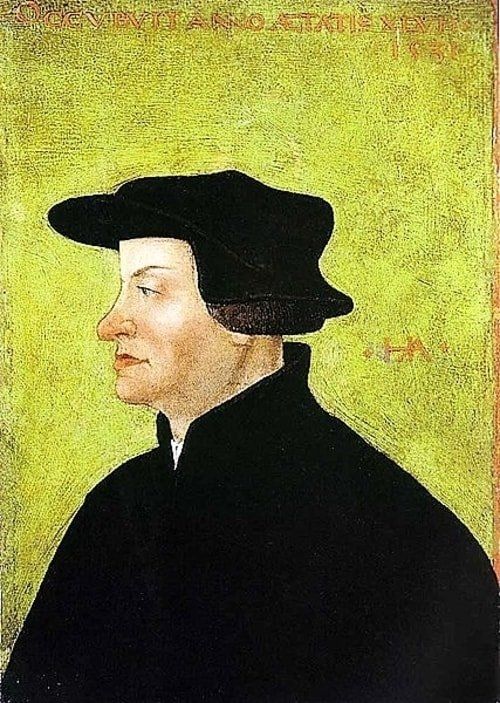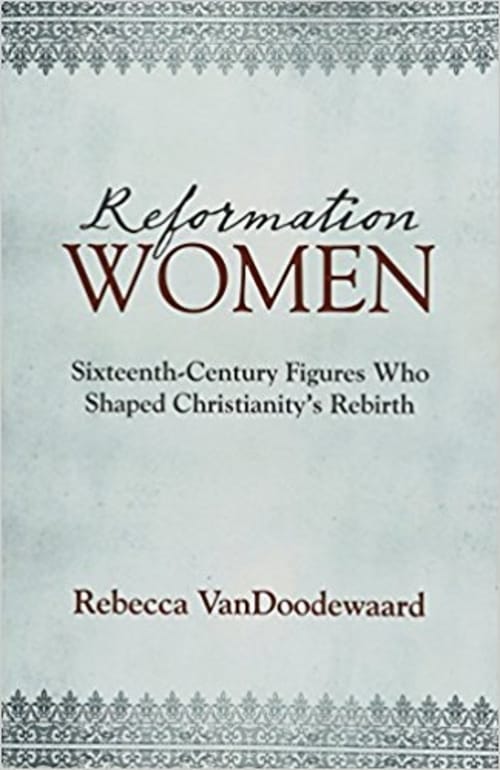Katharina Luther looms large in any discussion about Protestant women during the Reformation. She earned her acclaim through her work — and her high-profile, high-maintenance husband. But there were other women who also laboured for the newly revived church. They, too, have much to teach us.
The first woman to become a Reformer’s wife was Anna Reinhard (c.1484–1538). Like Calvin’s wife, Idelette, Anna was a young widow when her future husband arrived in town as the new priest.
We have no record of her birthdate, but many believe it was in 1484. We know little about her youth, except that she was beautiful and that a young, local nobleman, John von Knonau, wanted to marry her.
His family opposed the match, so John and Anna married in secret. When the news got out, John’s father cut him off, so he joined the Swiss army to support his wife. After several campaigns, he returned in broken health and died, leaving Anna a widow with a son and a daughter.
Zwingli
It was the son, Gerold, who brought his mother and Huldrych Zwingli together. Zwingli came to Zurich in late 1518, when Anna was struggling to support and train her family. From the beginning of Zwingli’s preaching ministry, she was one of his most attentive listeners. Her home was in his parish and he came in contact with her and her children as their pastor.
Gerold, in particular, came to Zwingli’s attention on account of the boy’s talents. Zwingli tutored the boy and, when Gerold needed higher education at age eleven, Zwingli sent him to Basel. Zwingli’s fatherly care for the son created a relationship with the mother and he soon fell in love with Anna.

Difficulties stood in the way of their relationship at first, for priests could not marry. So Zwingli and Anna secretly married in 1522, keeping the marriage hidden from all but Zwingli’s closest friends until 1524.
News of the marriage caused an international sensation, because Zwingli was the first Reformer to marry. Roman Catholics charged him with breaking his vows and marrying Anna for her beauty and her money. He replied that she had little money, but the charge that Anna’s beauty was part of what attracted him to her was not so bluntly refuted.
After marrying Zwingli, Anna stopped wearing jewelry. We don’t know her reasons. Maybe vanity was a personal vice; maybe she thought it would help the family financially. Perhaps the busyness of her new life crowded out all extras; her Protestant faith and marriage to a Reformer meant that her Christian service was multifaceted and intense.
‘Angel-wife’
Anna took great care of her husband. Zwingli called her his dearest housewife, a useful helpmeet to him. Though they spent happy evenings as a family, Zwingli had little spare time. When he became too absorbed in his work, rising early and working late, she would tell him, ‘Take a little more rest, my dear’.
She loved to hear Zwingli explaining aspects of Christ’s character that she had not understood. When her husband began translating the Bible in 1525, he read her the proof sheets in the evenings before bed. Anna loved hearing the gospel story in her own Swiss German tongue. When the complete Bible was published in 1529, Zwingli gave her a copy; it became her favourite book.
Only one letter from Zwingli to Anna has come down to us. It was written from Berne in 1528, when Anna gave birth in his absence. In it, he thanks the Lord for the arrival of a son, prays that both parents might be able to educate him well, urges Anna not to worry about his own safety, and sends greetings to friends.
Anna welcomed large numbers of her husband’s friends and entertained his guests. Protestant refugees were many in those days, and the Zwingli home was always open to them. When Zwingli was engaged or away, Anna was the centre of the circle.
Leading citizens and ministers such as Leo Juda and Konrad Pellikan gave her great credit and praise. In 1526, a visiting dignitary was so impressed by Zwingli’s home that he declared he would never forget it. He also called Anna ‘an angel-wife’.
Serious danger
But marriage to a Reformer was more than happy, hard work; there was serious danger as well. Zwingli lived in continual threat of assassination or kidnapping by Roman Catholics. He could not go out alone after dark, so Anna arranged for men to escort him.
He had to be careful where he ate or drank, for fear of poisoning. She frustrated many attempts on his life, but she also looked to him for protection. On 28 August 1525, their house was stoned at night; rocks sent pieces of wood flying through the house. Anna and the children were terrified, but Zwingli seized his sword, calling out that if anyone had any business with him, they should come the next morning.
These troubles foreshadowed coming sorrow. Anna and her husband saw the storm gathering. It burst on 11 October 1531. On 9 October news came that the Roman Catholic army was approaching Zurich. Zwingli went along with the Protestant force as chaplain. Gerold was also going.
Anna came out of the parsonage to say goodbye to her husband and burst into tears. ‘The hour is come that separates us’, he said to her. ‘Let it be so. The Lord wills’. He hugged her and she answered, ‘We shall see each other again, if the Lord wills. His will be done. And what will you bring back when you come?’ Zwingli’s prompt reply was, ‘Blessing after dark night’. These were his last words to her.
With the children, Anna hurried into the house, kneeled and prayed the Saviour’s words, ‘Father, not my will, but Thine be done’.
Bullinger says that at the news of the defeat, a horrible cry rose from Zurich. Many had lost loved ones, but Anna’s grief was different. She had faced sorrows before; this eclipsed them all. Her son Gerold, a brother and a cousin lay dead on the battlefield, along with her husband. A son-in-law also was fatally wounded. The sadness of death circled her.
Final years
Because of her griefs, Anna has been called the ‘Reformation’s weeping mother’. Prominent citizens and ministers visited her or wrote letters of Christian sympathy. Martin Bucer offered to help her and the children. But the greatest earthly comforter of all to her was young Heinrich Bullinger, her husband’s successor.
Just as the apostle John took Mary into his home, so Bullinger and his wife gave Anna a home and became beloved children to her. Zwingli had left his family no money. Bullinger took Zwingli’s place as provider and acted as a father to the children, supervising and paying for their education.
We know almost nothing of Anna’s later years. Apparently, she rarely left the house, except to go to church. In her later life, she was very sick for years, but she bore her sufferings patiently.
Bullinger said of her death on 6 December 1538: ‘I desire no more happy end of life. She passed away softly, like a mild light, and went home to her Lord, worshipping and commending us all to God’.
Anna’s life was driven by the principles she read in her Swiss Bible. She was not afraid to marry, despite massive opposition, because she knew it was right. She faithfully and carefully taught her children, following the precepts of Deuteronomy 6.
Her support of Zwingli freed him to work faithfully and he praised her in the gates. Her care for the poor and sick of the parish earned the trust of the people, who could see Christlikeness lived out in Anna’s example.

Anna also left a living legacy in her children, who continued her pattern of building up the church through kindness to the saints. Her faithful work outlived her body. Anna set the pattern for Protestant women, especially pastors’ wives. She had run well; others were waiting to follow.
Rebecca VanDoodewaard
This extract is edited, with kind permission, from Tabletalk, a devotional, online publication of Ligonier Ministries.
The author’s book - Reformation Women: Sixteenth-Century Figures Who Shaped Christianity’s Rebirth, is published by Reformation Heritage Books, 2017, 136 pages, ISBN:978-1601785329.







